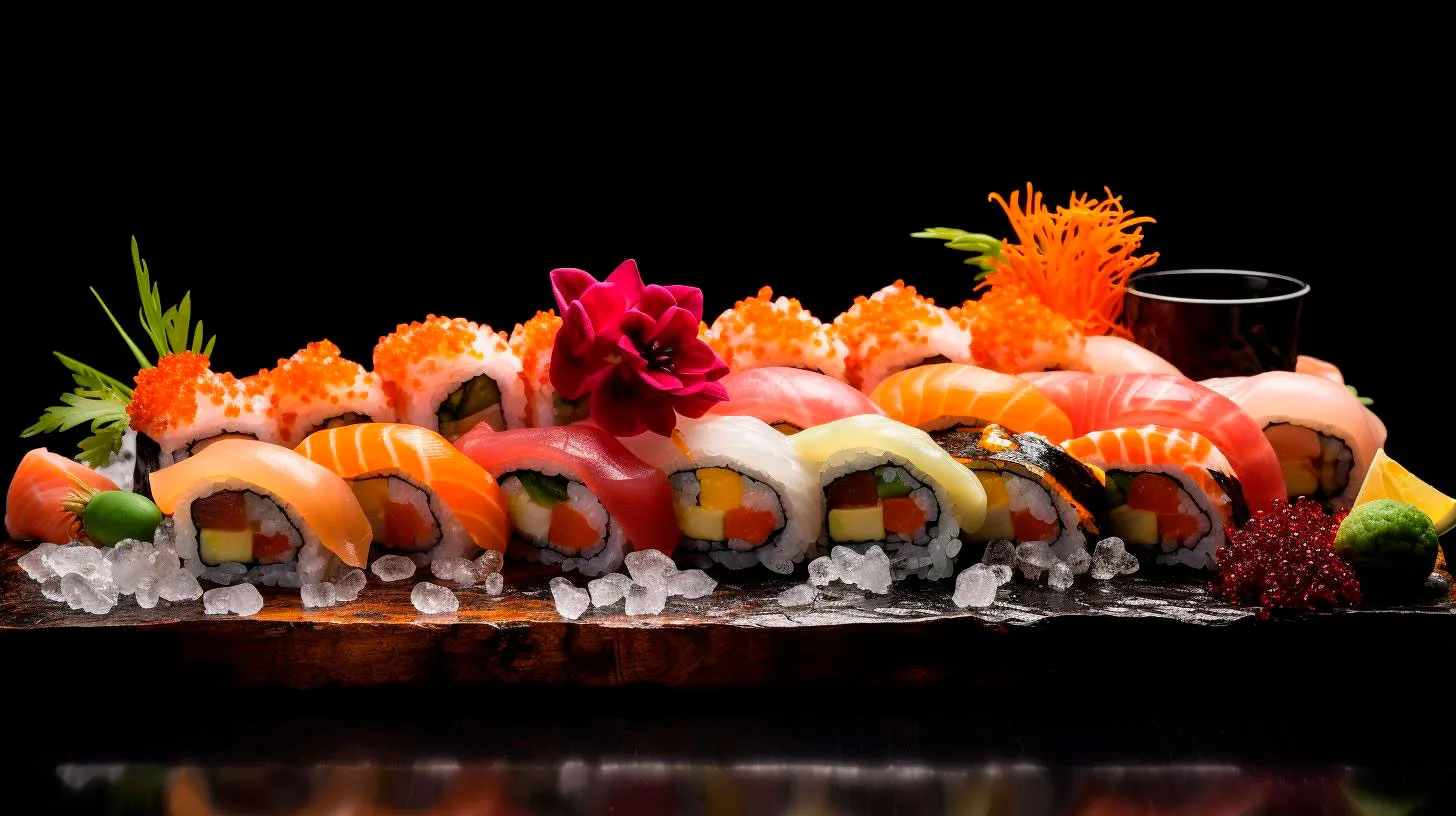From Heat to Sweet: Exploring the Fascinating World of Sushi and Wasabi Pairings
In this article, we will delve into the fascinating world of sushi and wasabi pairings, learning about the heat, the sweetness, and the harmony they bring to each bite.
The Origins of Wasabi
Before we explore the magic of sushi and wasabi, let’s take a moment to understand the origins of this green paste. Wasabi, scientifically known as Wasabia Japonica, is a plant native to Japan. Traditionally, the roots of this plant were grated to produce the spicy condiment we know today. Rich in antioxidants and antimicrobial properties, wasabi not only adds flavor but also serves as a natural preservative for sushi.
Today, wasabi is prepared by mixing horseradish, mustard, and food coloring, as authentic wasabi can be challenging to cultivate in large quantities. Nevertheless, the taste is still pungent, with a touch of heat, making it the perfect complement to sushi.
The Heat of Wasabi
Wasabi has a reputation for its intense, sinus-clearing heat that can often catch first-time sushi eaters by surprise. But why does it have this unique characteristic? The answer lies in a compound called allyl isothiocyanate. When the cell walls of the wasabi plant are damaged, this compound is released, resulting in the fiery sensation we associate with the condiment.
Interestingly, studies have shown that wasabi’s heat intensity can differ depending on the form it is consumed. For instance, sampling wasabi powder typically results in a more intense heat compared to wasabi paste due to the former being less diluted. Every sushi chef has their preference, and some even create their own unique wasabi blends to offer their patrons a memorable culinary experience.
The Sweetness of Sushi
While wasabi takes the spotlight as the fiery counterpart, the sweetness of sushi plays an integral role in balancing the flavors of this iconic dish. Sushi rice, or shari, is seasoned with a mixture of vinegar, sugar, and salt, giving it a subtly sweet taste. This not only enhances the flavor of the fish but also acts as a palate cleanser, preparing your taste buds for the next delightful bite.
The sweetness of sushi rice can vary, depending on the chef’s recipe and regional preferences. In the Kansai region of Japan, for example, sushi rice tends to be sweeter compared to the Tokyo style, offering a different dining experience for sushi lovers. The balance between the sushi’s sweetness and the heat of wasabi creates an irresistible combination.
Exploring Pairings: Features, Advantages, and Key Takeaways
1. Traditional Wasabi Pairings
- Classic nigiri sushi, topped with fish and a dab of wasabi, is a must-try pairing that showcases the harmonious balance between the heat and the sweetness.
- Wasabi also elevates the flavors of sashimi, cutting through the rich and buttery taste of fresh raw fish.
- If you’re a sushi roll enthusiast, try adding a touch of wasabi to your maki rolls for an extra kick.
2. Fusion Pairings
- For those who enjoy exploring new taste combinations, consider pairing sushi with wasabi-infused sauces or dressings.
- Wasabi mayonnaise or wasabi soy sauce adds an exciting twist to your sushi experience.
- Don’t forget about vegetarian options! Wasabi pairs well with avocado or tofu, providing a delightful contrast of flavors.
3. Pairing with Sake
- Sake, the traditional Japanese rice wine, offers a perfect accompaniment to sushi and wasabi.
- Pair lighter and drier sakes with delicate sushi flavors, while richer and fuller-bodied sakes complement bolder fish choices.
- The combination of the heat from wasabi and the smoothness of sake creates a satisfying mouthfeel.
As sushi continues to evolve and capture the hearts of food enthusiasts worldwide, the art of pairing it with wasabi adds another layer of enjoyment to this culinary journey. The heat of wasabi, the sweetness of sushi rice, and the diverse pairings available make for an unforgettable dining experience. Whether you prefer traditional combinations or exploring fusion flavors, there is a perfect match waiting to delight your taste buds.
So, the next time you savor a plate of sushi, be sure to appreciate and experiment with the fascinating world of sushi and wasabi pairings. Bon appétit!
Mastering the Balance: Delving into the Intricate Art of Matching Sushi with Wasabi
In this article, we explore the secrets behind mastering the balance of matching sushi with wasabi, unlocking a world of flavors and sensations.
Why Wasabi Matters
Before diving into the art of pairing, let’s understand why wasabi matters in the first place. Wasabi, or Japanese horseradish, is a staple condiment in Japanese cuisine. Its pungent and spicy flavor not only complements the raw fish but also serves as a natural antibacterial agent. Traditionally, wasabi is freshly grated from the rhizome of the Wasabia japonica plant, ensuring its sharp and distinctive taste.
1. Wasabi enhances the flavor: The unique heat of wasabi helps to elevate and intensify the flavors of sushi, creating a harmonious balance between the delicate flavors of the fish and the boldness of the condiment.
2. Wasabi cleanses the palate: The spiciness of wasabi acts as a palate cleanser, refreshing the taste buds between each sushi bite. It cuts through the fish’s richness and helps prepare your taste buds for the next piece.
3. Wasabi kills bacteria: One of the lesser-known advantages of wasabi is its antibacterial properties. This natural condiment helps to safeguard against potential foodborne illnesses that can be present in raw fish, making it a vital component in ensuring a safe and enjoyable sushi experience.
Matching Sushi with Wasabi: The Art and Science
Now that we understand the importance of wasabi, let’s explore the art and science behind matching sushi with this green delight.
Know your Sushi
Each piece of sushi comes with its unique characteristics, requiring careful consideration when pairing it with wasabi.
- Tuna: With its rich and fatty flavor, tuna pairs well with a generous amount of wasabi, as it can handle the heat without overpowering the taste.
- Salmon: The buttery texture and mild taste of salmon can be accentuated with just a hint of wasabi, allowing its delicate flavors to shine.
- Eel: The sweet and savory taste of eel requires a subtle touch of wasabi, enhancing its natural flavors without overpowering them.
The Perfect Balance
Achieving the perfect balance between sushi and wasabi requires precision and finesse. Here are a few key tips to keep in mind:
- Start with a small amount: Begin by adding a small portion of wasabi to your sushi. You can always add more if desired, but it’s difficult to remove if you overshoot.
- Use ginger as a palette cleanser: Take small bites of pickled ginger between sushi bites to cleanse your palate and enjoy the subtle flavors of each piece.
- Experiment with different amounts: The ideal amount of wasabi varies for each person. Some prefer a gentle hint, while others enjoy a more intense kick. Experiment to find your perfect balance.
- Consider sushi toppings: Sushi with stronger toppings like spicy mayo or soy-based sauces may require less wasabi, as these flavors already provide a kick.
Key Takeaways
Mastering the art of matching sushi with wasabi can truly elevate your sushi experience. Remember these key takeaways:
- Wasabi enhances the flavor and acts as a palate cleanser.
- Knowing your sushi types helps you pair them in the most optimal way.
- Start with small amounts of wasabi and experiment to find your preferred balance.
- Use pickled ginger to cleanse your palate between bites.
By understanding the science behind sushi and wasabi pairing, you can unlock a world of flavors and sensations. So next time you sit down for a sushi meal, take a moment to appreciate the delicate balance of sushi and wasabi, and let your taste buds indulge in this intricate art form.
The Limits of Wasabi: Perfecting the Art of Pairing Sushi
This captivating condiment not only adds a punch of flavor to your meal but also enhances the overall experience of enjoying sushi. In this article, we will delve into the limits of wasabi and explore the art of pairing sushi.
The Essence of Wasabi
Wasabi is a pungent and highly aromatic condiment that hails from the root of the Wasabia japonica, a plant native to Japan. This green-colored paste is well-known for its fiery kick and distinct flavor. Widely regarded as a must-have accompaniment for sushi, wasabi is often misunderstood.
Traditionally, real wasabi is derived from grating the root of the Wasabia japonica plant. However, due to its scarcity and high cost, most restaurants and sushi bars now use a substitute made from horseradish, mustard, and food coloring. Although the taste and aroma may be different, these substitutes still provide a satisfying experience when paired with sushi.
Mastering the Art of Pairing
Pairing the right amount of wasabi with your sushi is an art form that should not be underestimated. Too much wasabi can overpower the delicate flavors of the fish, while too little can leave your taste buds craving that fiery kick.
Here are some key takeaways to keep in mind when pairing sushi with wasabi:
- Start with a small amount: Begin with a small dab of wasabi and mix it into your soy sauce. This allows the wasabi to infuse gently with the soy sauce, creating a harmonious balance of flavors.
- Experiment with different amounts: Gradually increase the amount of wasabi to find your preferred level of spiciness. Remember, the goal is to enhance the flavors and not overpower them.
- Apply wasabi sparingly: Aim to apply wasabi between the rice and fish or simply on top of the fish. Avoid directly smearing it on the rice as it can dampen the taste and texture.
The Advantages of Pairing Sushi with Wasabi
Pairing sushi with wasabi offers several advantages that elevate your dining experience:
- Enhances flavor: Wasabi adds a unique kick that complements the taste of sushi, intensifying every bite.
- Antibacterial properties: Wasabi contains compounds that possess antibacterial properties, aiding in the preservation of raw fish and ensuring food safety.
- Clears nasal passages: The pungent aroma of wasabi can help clear your sinuses and enhance your sense of taste, allowing you to fully appreciate the subtle flavors of your sushi.
Understanding Sushi Etiquette
Appreciating the art of pairing sushi with wasabi extends beyond choosing the perfect amount. Understanding the etiquette behind consuming sushi is equally important to ensure an authentic experience.
Some sushi etiquette tips include:
- Use chopsticks or your hands: Depending on the type of sushi, it is acceptable to use chopsticks or your hands when eating sushi. Follow the lead of other diners or ask the sushi chef for guidance.
- Consume in one bite: Sushi is delicately crafted, and it is customary to consume each piece in a single bite to fully savor the combination of flavors.
- Follow the recommended order: Sushi is often served in a specific order, designed to gradually introduce flavors. Trust the chef’s expertise and enjoy the progression.
Conclusion
Wasabi may have its limits, but it remains an essential component in the world of sushi. As you embark on your sushi journey, remember the art of pairing sushi with wasabi. Discover your preferred level of spiciness and savor the unique flavors that each bite brings. So the next time you indulge in this delectable Japanese delicacy, add just the right amount of wasabi to elevate your sushi experience to new heights.
Unlocking Culinary Harmony: Understanding the Complexities of Sushi and Wasabi
What is Sushi?
Sushi is not just a simple roll of fish and rice; it is an intricate culinary masterpiece that dates back centuries. Originating in Southeast Asia, sushi has evolved into various forms, each with its own unique twist. From nigiri, where a slice of raw fish sits atop a small mound of vinegared rice, to maki, which consists of various fillings wrapped in seaweed and rice, sushi offers a diverse range of flavors and textures.
Key Takeaways:
- Sushi is a versatile Japanese dish with various forms like nigiri and maki.
- It offers an exciting combination of flavors and textures.
Understanding Wasabi
Often mistaken for avocado due to its similar appearance, wasabi is a fiery condiment that adds a distinct punch to sushi. Made from the root of the Wasabia Japonica plant, true wasabi can be quite rare and expensive. As a result, many sushi restaurants substitute it with a powder mixed with water, resulting in a paste-like consistency.
Key Takeaways:
- Wasabi is a spicy condiment that accompanies sushi.
- True wasabi comes from the Wasabia Japonica plant.
The Culinary Harmony
The combination of sushi and wasabi is a perfect example of culinary harmony. When eaten together, sushi and wasabi create a symphony of flavors that leave your taste buds tingling with delight. The spiciness of wasabi counteracts the rich and subtle flavors of the fish, enhancing the overall experience of the dish.
Key Takeaways:
- Wasabi complements and enhances the flavors of sushi.
- Its spiciness balances the rich fish flavors.
Health Benefits of Wasabi
Beyond its culinary significance, wasabi also offers several health benefits. It is packed with antioxidants that help protect against cell damage and reduce the risk of chronic diseases. Additionally, wasabi contains antimicrobial properties that may help fight off bacteria and prevent food poisoning.
Key Takeaways:
- Wasabi is rich in antioxidants, which promote overall health.
- Its antimicrobial properties may aid in preventing food poisoning.
Tips for Enjoying Sushi and Wasabi
To fully experience sushi and wasabi, here are some tips to keep in mind:
- Choose high-quality sushi: Fresh ingredients are crucial to enjoying sushi at its best.
- Use wasabi sparingly: Wasabi is potent, so start with a small amount and gradually add more to suit your taste.
- Savor the flavors: Take your time to appreciate the intricacies of each sushi roll and the effects of wasabi.
Key Takeaways:
- Opt for fresh ingredients for the best sushi experience.
- Use wasabi in moderation to avoid overpowering your taste buds.
- Take your time and savor the flavors of each sushi roll.
Conclusion
Sushi and wasabi have become synonymous with Japanese cuisine for a reason. The delicate balance of flavors, textures, and culinary techniques creates a culinary experience like no other. Whether you are a sushi aficionado or a curious beginner, understanding the complexities of sushi and the role of wasabi will undoubtedly enhance your appreciation for this timeless gastronomic delight.



